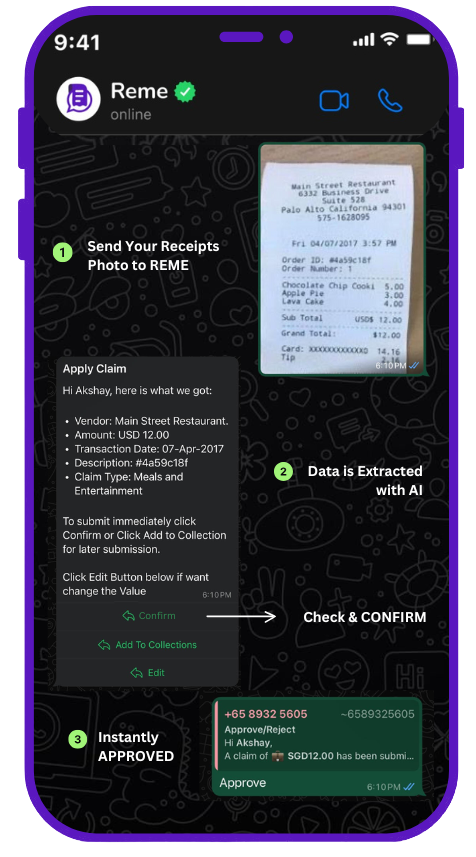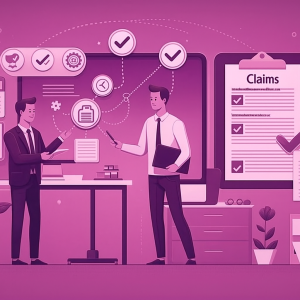In the modern business landscape, expense management remains one of the most persistent operational challenges organizations face. The traditional expense process—collecting paper receipts, manually completing reports, routing for approvals, and processing reimbursements—consumes valuable time, introduces errors, and frustrates everyone involved. Yet many companies continue to accept these inefficiencies as unavoidable costs of doing business.
This acceptance is no longer necessary. End-to-end automation is transforming expense management from a cumbersome administrative burden into a streamlined, nearly invisible process. By leveraging AI and messaging platforms like WhatsApp, organizations can now automate the entire journey from receipt capture to employee reimbursement—saving time, reducing errors, and dramatically improving the experience for all stakeholders.
The Traditional Expense Workflow: A Study in Inefficiency
Before exploring automation benefits, let’s examine the traditional expense workflow and its inherent inefficiencies:
Stage 1: Receipt Collection and Organization
Traditional Process: Employees collect paper receipts, often losing or damaging them before submission. Digital receipts get buried in email inboxes. Pain Points: Lost receipts, disorganization, delayed submissions
Stage 2: Expense Report Creation
Traditional Process: Employees manually enter receipt data into forms or spreadsheets, categorize expenses, and attach receipt images. Pain Points: Time-consuming data entry, categorization errors, delayed submissions
Stage 3: Policy Compliance Review
Traditional Process: Employees self-verify policy compliance, often misinterpreting rules or making honest mistakes. Pain Points: Inconsistent policy application, high exception rates
Stage 4: Approval Routing
Traditional Process: Reports route to managers who review line items, verify receipts, and approve or reject submissions. Pain Points: Approval bottlenecks, inconsistent enforcement, limited visibility
Stage 5: Payment Processing
Traditional Process: Finance teams manually enter approved expenses into accounting systems and process reimbursements. Pain Points: Duplicate data entry, reconciliation challenges, delayed reimbursements
Stage 6: Accounting and Reporting
Traditional Process: Finance teams manually categorize expenses, allocate costs, and generate reports. Pain Points: Delayed financial visibility, manual reconciliation, limited analytics
This traditional workflow typically requires 2-3 weeks from expense occurrence to employee reimbursement, consumes hours of productive time across multiple roles, and introduces numerous opportunities for errors and delays.
The Automated Alternative: A Streamlined End-to-End Process
Modern expense automation transforms this cumbersome process into a streamlined workflow that minimizes manual intervention:
Stage 1: Intelligent Receipt Capture
Automated Process: Employees photograph receipts with their smartphone and send them directly to the expense system via WhatsApp. For digital receipts, they simply forward emails or share PDFs. Technology Enablers: Computer vision, OCR (Optical Character Recognition), natural language processing Benefits: Immediate capture at the point of purchase, elimination of physical receipt management, 24/7 submission capability
Stage 2: Automated Data Extraction and Categorization
Automated Process: AI instantly extracts merchant name, date, amount, and line items from receipts, automatically categorizing expenses based on merchant type and transaction patterns. Technology Enablers: Deep learning, pattern recognition, historical data analysis Benefits: Elimination of manual data entry, 99.7% extraction accuracy, consistent categorization
Stage 3: Real-Time Policy Compliance
Automated Process: The system automatically evaluates expenses against policy rules, flagging exceptions and providing immediate feedback to employees when issues arise. Technology Enablers: Rules engines, machine learning, contextual analysis Benefits: Consistent policy application, preventative compliance, reduced exceptions
Stage 4: Intelligent Approval Routing
Automated Process: Compliant expenses route automatically to appropriate approvers based on amount, category, and organizational hierarchy. Managers receive mobile notifications and can approve with a single tap. Technology Enablers: Workflow automation, mobile push notifications, smart routing algorithms Benefits: Elimination of approval bottlenecks, consistent enforcement, anywhere/anytime approval capability
Stage 5: Automated Reimbursement Processing
Automated Process: Approved expenses automatically flow to accounting systems and trigger reimbursement processes without manual intervention. Technology Enablers: API integrations, payment automation, reconciliation algorithms Benefits: Elimination of duplicate data entry, accelerated reimbursement cycles, reduced processing errors
Stage 6: Automated Accounting and Analytics
Automated Process: The system automatically allocates expenses to appropriate general ledger accounts, cost centers, and projects while generating real-time spending analytics. Technology Enablers: Accounting integrations, data visualization, predictive analytics Benefits: Real-time financial visibility, automated reconciliation, actionable spending insights
This automated workflow typically reduces the expense cycle from weeks to days (or even hours), eliminates most manual tasks, and delivers near-perfect accuracy throughout the process.
Key Components of a Fully Automated Expense System
Achieving end-to-end automation requires several integrated components working in harmony:
Mobile Receipt Capture
The foundation of automation is immediate receipt capture at the point of purchase. WhatsApp integration provides the ideal interface—ubiquitous, familiar, and always available. Employees simply photograph receipts and send them to a dedicated WhatsApp number, initiating the automated workflow instantly.
AI-Powered Data Extraction
Advanced machine learning algorithms extract structured data from unstructured receipt images with remarkable accuracy. The system recognizes merchant names, dates, amounts, currencies, payment methods, and even individual line items without human intervention.
Smart Expense Categorization
Rather than forcing employees to manually categorize expenses, AI automatically assigns appropriate categories based on:
- Merchant type classification
- Purchase patterns and history
- Transaction context and timing
- Employee role and department
This intelligent categorization achieves higher accuracy and consistency than manual assignment.
Dynamic Policy Enforcement
Automated systems apply expense policies consistently and contextually, considering:
- Employee role and seniority
- Transaction location and circumstances
- Business purpose and justification
- Project and client associations
The system provides immediate feedback when policy issues arise, enabling correction before submission rather than after-the-fact rejection.
Intelligent Workflow Automation
Modern systems replace rigid approval chains with intelligent routing based on:
- Risk assessment of each transaction
- Amount thresholds and expense types
- Manager availability and workload
- Regulatory and compliance requirements
This dynamic routing ensures appropriate oversight without unnecessary delays.
Seamless Integration Ecosystem
True end-to-end automation requires seamless connection between:
- Corporate card programs
- Accounting and ERP systems
- Human resources platforms
- Banking and payment systems
- Travel booking tools
These integrations eliminate system boundaries and enable continuous data flow throughout the process.
Real-Time Analytics Engine
Automated expense systems transform raw transaction data into actionable intelligence through:
- Spending pattern analysis
- Budget variance identification
- Vendor concentration metrics
- Policy compliance tracking
- Anomaly and fraud detection
These insights enable proactive expense management rather than reactive reporting.
Implementation Approach: The Path to Full Automation
Implementing end-to-end expense automation requires a thoughtful approach to ensure successful adoption:
Phase 1: Assessment and Planning
- Audit current expense processes and identify pain points
- Define automation objectives and success metrics
- Evaluate technical requirements and integration points
- Develop implementation timeline and resource plan
Phase 2: Core Implementation
- Configure WhatsApp integration for receipt capture
- Train AI models for your specific receipt formats
- Implement basic workflow automation
- Establish accounting system integrations
Phase 3: Advanced Automation
- Activate intelligent policy enforcement
- Implement dynamic approval routing
- Enable automated payment processing
- Deploy analytics and reporting capabilities
Phase 4: Optimization and Expansion
- Refine AI models based on organization-specific patterns
- Extend automation to additional expense types
- Implement advanced fraud detection capabilities
- Integrate with additional business systems
This phased approach allows organizations to realize incremental benefits while building toward comprehensive automation.
Measuring Automation Success: Key Performance Indicators
To evaluate the impact of expense automation, track these metrics before and after implementation:
Process Efficiency Metrics
- Average time from expense occurrence to submission
- Average time from submission to approval
- Average time from approval to reimbursement
- Total hours spent on expense processing (all roles)
Accuracy and Compliance Metrics
- Data extraction accuracy rate
- Expense categorization accuracy
- Policy exception rate
- Audit findings related to expenses
Financial Impact Metrics
- Direct processing cost per expense report
- Average reimbursement cycle time
- Duplicate payment incidents
- Identified fraud or misuse cases
User Experience Metrics
- Employee satisfaction with expense process
- Manager satisfaction with approval process
- Finance team satisfaction with reconciliation process
- System adoption rates across departments
Real-World Success Stories: Automation in Action
Global Consulting Firm
A professional services organization with 5,000 consultants implemented end-to-end expense automation with these results:
- 91% reduction in expense processing time
- 99.2% data extraction accuracy
- 78% decrease in policy exceptions
- $1.2M annual cost savings in administrative time
- Reimbursement cycle reduced from 15 days to 3 days
Manufacturing Company
A mid-sized manufacturer with global operations achieved:
- 84% of expenses submitted within 24 hours of occurrence
- 94% reduction in paper receipt handling
- 100% receipt capture (up from 76%)
- $430,000 annual savings in processing costs
- Real-time visibility into project-related expenses
Technology Startup
A rapidly growing software company implemented automated expenses during expansion:
- Scalable processing from 200 to 1,500 employees without adding finance headcount
- 97% employee satisfaction with the expense process
- 100% mobile submission rate via WhatsApp
- Complete elimination of expense backlog at month-end
- Real-time budget tracking across all departments
Overcoming Implementation Challenges
While the benefits of expense automation are compelling, organizations may face challenges during implementation:
Integration Complexity
Challenge: Connecting with legacy financial systems can be technically challenging. Solution: Use middleware and API frameworks to bridge modern and legacy systems without replacing core infrastructure.
User Adoption
Challenge: Employees accustomed to traditional processes may resist new approaches. Solution: Leverage familiar interfaces like WhatsApp, demonstrate clear personal benefits, and provide seamless transition support.
Data Quality
Challenge: AI systems require quality data to perform optimally. Solution: Implement progressive machine learning that improves over time with organizational-specific transaction patterns.
Policy Digitization
Challenge: Translating nuanced expense policies into automated rules can be complex. Solution: Start with core policies and progressively implement more sophisticated rules as the system matures.
Security Concerns
Challenge: Digital expense systems must maintain rigorous security standards. Solution: Implement end-to-end encryption, secure authentication, and comprehensive access controls throughout the automation workflow.
The Future of Expense Automation: What’s Next?
As expense automation technology continues to evolve, several emerging capabilities will further transform the process:
Predictive Expense Management
AI will anticipate expenses before they occur, suggesting optimal timing, vendors, and payment methods based on historical patterns and business activities.
Dynamic Policy Optimization
Machine learning will analyze spending patterns and business outcomes to recommend policy adjustments that balance employee flexibility with cost control objectives.
Autonomous Spend Reconciliation
Advanced algorithms will automatically match expenses to budgets, projects, and financial forecasts without human intervention, enabling continuous financial close capabilities.
Conversational Expense Interfaces
Natural language processing will enable employees to submit and manage expenses through conversational interactions rather than structured forms.
Proactive Fraud Prevention
AI systems will identify potential policy abuse or fraud before transactions occur, preventing issues rather than detecting them after the fact.
Conclusion: The Automated Expense Imperative
End-to-end expense automation is no longer a luxury—it’s a competitive necessity. Organizations that continue to rely on manual or partially automated expense processes face significant disadvantages in efficiency, accuracy, and employee experience.
The most forward-thinking companies recognize that expense management isn’t merely an administrative function but a strategic opportunity to:
- Redirect valuable human resources toward higher-value activities
- Generate actionable financial intelligence through spending data
- Deliver exceptional employee experiences that attract and retain talent
- Create financial operations that scale effortlessly with business growth
By implementing comprehensive automation from receipt to reimbursement, organizations transform expense management from a necessary burden into a strategic advantage—one that delivers measurable bottom-line impact while improving experiences for everyone involved.



